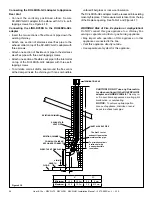
Heat & Glo • REVO-V12, REVO-S21, REVO-H31 Installation Manual • 2273-980 Rev. J • 5/15
26
Figure 4.18
TERMINATION CAP
EXISTING CHIMNEY
EXISTING CHIMNEY
EXHAUST AIR
VENT PIPE
V
FLOOR
HEARTH
H
To minimize cold air
drafts, seal with
non-combustible
insulation.
DIRECT VENT FIREPLACE
COAXIAL/COLINEAR
APPLIANCE CONNECTOR
INLET AIR VENT PIPE
The first 3 feet of
exhaust flue must be
stainless flex pipe.
4 IN. MIN.
V
H
Minimum
10 ft.
3.05 m
0 ft.
0 mm
Maximum
40 ft.
12.2 m
2 ft.
610 mm
NOTICE:
To achieve optimum perfor-
mance of appliance, minimize or avoid
bends in exhaust vent pipe.
CAUTION! DO NOT
use any flue restric
-
tor when venting with the DV-46DVA-GCL
adapter and LINK-DV30B kit.
This may re-
sult in poor flame appearance, sooting, pilot
malfunction, or overheating.
Connecting the DV-46DVA-GCL Adapter to Appliance
Rear Vent
• Connect the vertically positioned elbow. Secure
DV-46DVA-GCL adapter to the elbow with 3-1/2 in. self-
tapping screws. See Figure 4.18.
Connecting the LINK-DV30B to the DV-46DVA-GCL
adapter
• Insert the two sections of flexible vent pipe down the
existing chimney.
• Attach one section of stainless steel flex pipe to the
exhaust collar on top of the DV-46DVA-GCL adapter with
three screws.
• Attach one section of flexible vent pipe to the stainless
steel flex pipe with three self-tapping screws.
• Attach one section of flexible vent pipe to the inlet collar
on top of the DV-46DVA-GCL adapter with three self-
tapping screws.
• To minimize cold air drafts, seal around the flex vents
at the damper inside the chimney with non-combustible
WARNING! Risk of Fire, Explosion or Asphyxiation!
Do NOT connect this gas appliance to a chimney flue
serving a separate solid fuel or gas burning appliance.
• May impair safe operation of this appliance or other
appliances connected to the flue.
• Vent this appliance directly outside.
• Use separate vent system for this appliance.
unfaced fiberglass or rock wool insulation.
The DV-46DVA-GCL adapter must be recessed into existing
masonry fireplace. This measurement is taken from the top
of the fireplace opening. See Table 1 and Figure 4.17.
















































